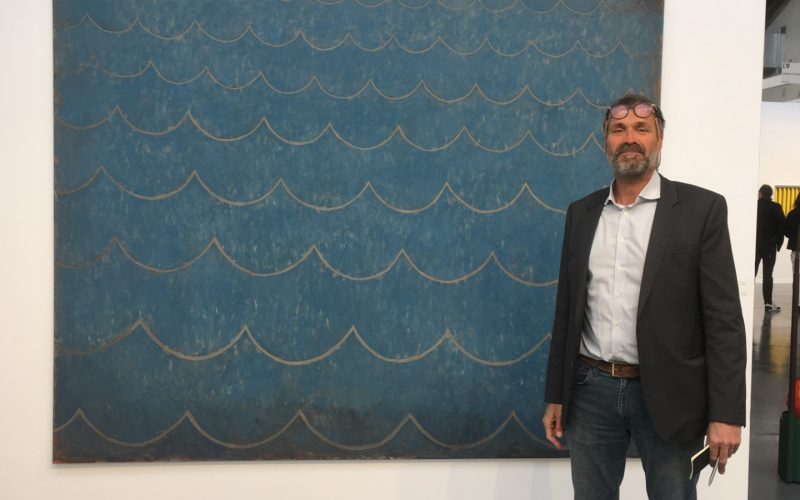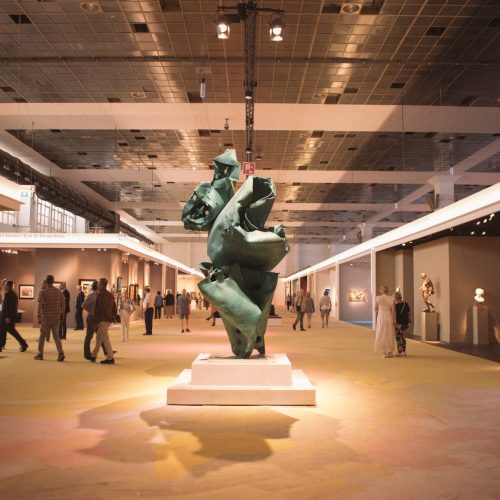
“I am an art advisor. I work with a small group of clients, mostly individuals all over the word; U.S., The Netherlands, Hong Kong, and help with forming art collections. I’m mostly focusing on works that have early upside, so I don't usually bring clients to an auction house and buy whatever is the flavor of the day, but I try to kind of predict. And earn my keep, so to say, by advising people to buy things that they love, but also things that will become more valuable. Especially since art has become very expensive over the last fifteen, twenty years, it makes sense to look at it from a dual perspective: enjoyment, but also investment.”
“Usually quite a few of them. The Basel Art Fairs, in Basel, Miami and Paris. Art Cologne, Art Dusseldorf. The Brussels and Antwerp art fairs. Local art fairs like Art Rotterdam and PAN Amsterdam. Freeze in London of course, where there are several satellite fairs happening, as there are in Miami. The Armory in New York, The Independent. So yeah, I go there a lot. it's a circus.”
“Recently I’ve been focusing on artists that have been overlooked. For example, the deceased Italian painter Salvo. His work is very different from a lot of the ‘arte povera’ Italian work that everybody knows. It’s very figurative, very colorful, during his lifetime probably misunderstood as decorative. A few years ago, I saw a show in New York with an important gallery and thought: Hey, this is something new, something else, and it's obviously being reconsidered. That was a good artist to get into.”
“I also recently bought a painting for a client by Friedrich Kunath. I've been following him for quite a while, he's been around for a long time. Mid-mid-career, good collections, and suddenly he got representation by a very good gallery in Europe, which can be a turning point. Usually it's the other way around, that a European artist will get a very good representation in the U.S., which is still the most important market. But Cunat moved to Europe and started working with Max Hetzler, a very good gallery. Then you kind of know they're going to really work on the European market. So I got works from him in the past and now I got a work from this show. I've just heard that he's going to do something with Larry Gagosian in New York, who is like the kingmaker. So, it looks like that is a career that will continue to flourish.”
“I've visited art fairs basically since the beginning of my career. Even when I couldn't afford to go, I would travel to Miami from New York, and I would stay in a youth hostel. I would go to the fair and beat the bush, be on the prowl, meet people, see things, ask questions, do my homework. Yeah, art fairs changed. In the beginning it was something new and exciting. Everybody was there. If something sold, people talked about it. And if it sold for a lot of money, it was the buzz of the fair. Now, of course, art fairs have become the cornerstone of the art market. They are totally inevitable, and stuff sells all the time. It's become a very important part of every gallerist's business model to be at a fair and sell to collectors that aren't their usual people. I know that for lots of European galleries most of their volume will come from American clients. They meet them at American fairs, so they have to go there.”
“They’ve become very commercial. But I must also say that there is a tremendous amount of fair fatigue. There are so many art fairs that if you were to go to all of them, it would basically be a constant relocation. And in truth, how much significant art can be produced to make you pay attention over and over again? Do the math: a good artist is represented by three, four different galleries. They all go to these fairs, so he's got to do a painting for all of them. So, there is a shitload of art out there that is just being made to be consumed. If you go long enough and often enough, you see that's all it is: it's a product, and it becomes a little boring. But then again, if you're with a client, and they are eager to buy some things to put in their house, it's very convenient to go to an art fair. And for me it remains part of doing my homework. But I prefer a dedicated exhibition at a gallery in some city, where the artist has gone all out and worked at the show for years. Where you can go to and it's quiet, and you can consider the work without the pressure of sales.”
“No. I'm on the VIP list of almost every art fair in the world. And I get these invitations emailed to me every year. All I have to do is confirm that I come, and I can go. That never goes wrong.”
“The good fairs all have a very easily navigable app now, where you can confirm your attendance, invite guests, and read what's happening concurrent with the fair in the town that it's at. You might even be able to book a hotel through the app. And of course, there are these online viewing rooms, OVR’s as they call them, where you can start hawking the work in advance of the fair. So all fairs are online now and sometimes you can visit these fairs without even actually going there. But of course, that misses speaking to the people and all that.”
“I think they'll always be part of the art economy that we’re in. For galleries they are important because people don't come to shows anymore. When a fair hits town, people go there, and galleries can meet lots of collectors. You always hear dealers say: well, sales were so-so, but we met a lot of people for future reference. Galleries pay hundreds of thousands of dollars to have a booth and ship work and put employees in the booth to talk to people. Art fairs have become super expensive. That’s why I think that there will probably be a consolidation of art fairs, because it's an unsustainable model to have that many and because there just isn't enough good work made to be sold at all these fairs. So some fairs will probably disappear, and a few very large, very important fairs will remain. Like what happened with the FIAC, that was the big Paris art fair and has now been overtaken by the Basel Art Fair.”
“Maybe sponsoring. It's very interesting to sponsor an art fair. Big banks, insurers, they all have their booths at art fairs, where they invite their clients. Art fairs have become the new golf, where you meet people and discuss other business than just the art business. It’s surely a very interesting thing to partake in, if the crowd you aspire to reach is not only people with lots of money to spend on art, but also creative people who are just there to get ideas. Art fairs offer an attractive mix of people, so I think sponsoring an art fair is a very interesting thing to do as a brand.”
